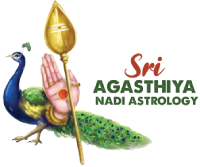History of Nadi Astrology
The Ancient Roots of a Divine Science
The tradition of Nadi Astrology, also called Nadi Jothidam or palm-leaf reading, is a rare and extraordinary form of wisdom emerging from South India, especially from the sacred region around Vaitheeswaran Koil in Tamil Nadu.
According to ancient accounts, the great sages (rishis) such as Agastya, along with other seers, perceived through their yogic vision the past, present, and future lives of souls destined to seek them out. They recorded these revelations on palm-leaf manuscripts known as Nadi Granthas.
The term “Nadi” in Tamil carries the meaning of “that which is sought” or “seeking one’s destiny”, expressing the seeker’s journey to find their leaf among the preserved manuscripts.
Manuscript Formation and Preservation
In its early phase, some of these records were believed to have been written on animal skins or other older media, and later transcribed onto palm leaves for durability. The palm leaves themselves were often derived from the talipot palm and inscribed with ink or stylus in Tamil script (including the older form “Vattezhuthu”).
Over centuries, the bundles of leaves were carefully preserved by specialist families of Nadi-readers near temples like Vaitheeswaran Koil, where the tradition flourished.
During the reign of southern dynasties such as the Cholas, the manuscripts were cataloged and safeguarded, but later, under colonial rule, many records were lost, moved, or dispersed, yet the tradition survived through dedicated custodians.
The Unique Method of Nadi Leaf Matching
What makes Nadi Astrology radically different from horoscope-based systems is the method of matching the thumb-impression of the seeker (right thumb for men, left thumb for women) to locate the specific bundle of leaves that corresponds to them. This sacred thumbprint acts as a key to the manuscript bank.
Once the correct leaf is found, the Nadi reader reveals the details inscribed by the sage, including life events, family history, past lives, current karmas, and future possibilities, often with instructions for remedial actions or spiritual practices (pariharam).
Significance of Sage Agastya and the Tamil Legacy
Among the rishis attributed to composing Nadi manuscripts, Agastya is especially revered. He is a central figure in the Tamil and pan-Indian spiritual tradition, credited with profound insight, siddha practices, and linguistic scholarship. The manuscripts attributed to the Agasthya tradition thus carry the name “Agasthya Nadi” in many centers.
Relevance in the Modern Era
Today, Nadi Astrology offers seekers a window into more than just personal prediction; it provides a sense of spiritual lineage, karmic continuity, and guidance rooted in ancient wisdom. The preserved manuscripts and the living tradition of Nadi reading form a bridge from that timeless knowledge to the present life quest.
At Sri Agasthiya Nadi Astrology, we honor this legacy, combining the spiritual depth of this ancient science with compassionate modern practice to serve you.
